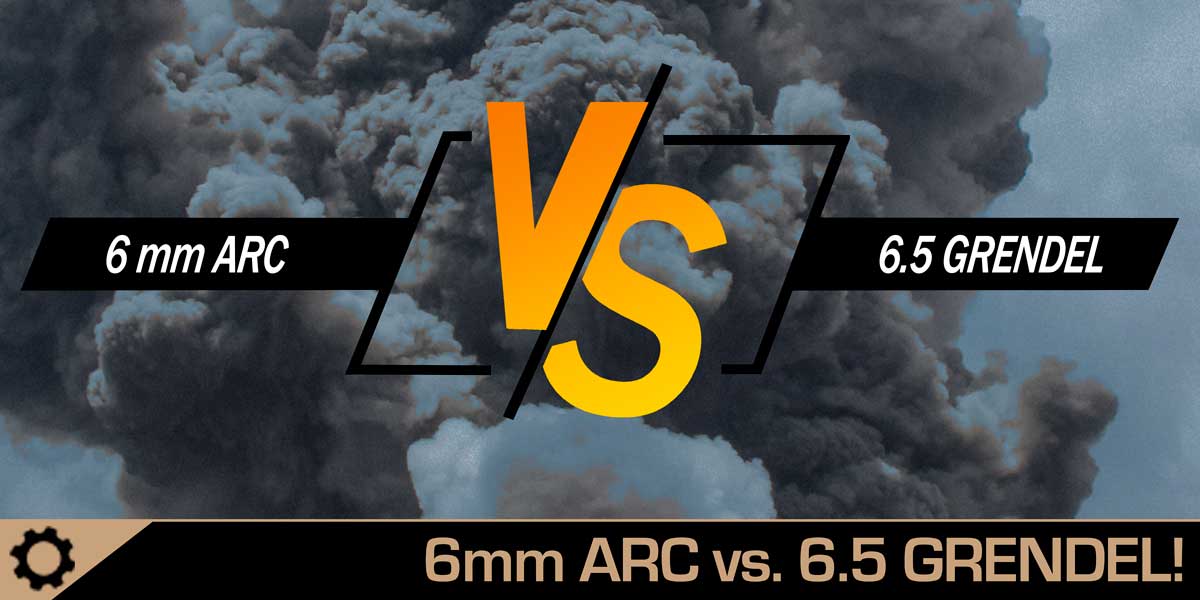
When I heard rumors of a new 6mm cartridge from Hornady, I was intrigued. Yeah, these days we see a lot of “new” cartridges that just duplicate the ballistics of existing cartridges. They offer little more than a shiny new name and slick marketing. I’ve done my research and here’s what I’ve found comparing 6mm ARC vs. 6.6mm Grendel.
We can start here: Hornady has done a lot to advanced bullet and ammunition design. They solved some problems that plagued ballisticians and bullet designers for decades.
Why 6mm Rounds?
I’m also a big fan of cartridges firing bullets in the 6mm, 6.5mm and 7mm diameters (.243, .264, .284). The reason? Long ago I learned to discard the hype about energy transfer and knock-down power. Instead, I concentrate scientifically on how the bullet acts between the muzzle and the target, and what it does after it strikes the target.
Bullets in these caliber ranges perform. They perform on the way to the way to the target, and they perform once they get there. They perform because it is possible to combine the right balance of features in a reasonable cartridge, fired by a reasonable rifle. Not surprisingly, then, here at SHWAT we’ve covered the 6.5 Grendel extensively. For example, take a look at our Maker Bullets 6.5 Grendel experience. Remington and Barnes have new 6.5 Grendel options we test while hog hunting. And our very popular comparison of the 6.5 Grendel vs. .308 story has generated a lot of conversation.
As bullet diameters grow larger, getting performance requires much heavier bullets. That, in turn, which requires more powder to move them. Which then creates the need for larger cases and much larger and heavier guns. So when we reach the .308 (7.62mm) or 8mm (.323 cal.) cartridges, we see a compromise toward less effective bullet design in order to keep recoil down, cartridge length at existing standards, and rifles reasonably light.
I have long viewed the 6.5mm cartridge family as ideal for the vast majority of both sporting and military uses. Their trajectories can match larger magnum chamberings and their bullets retain velocities better, allowing reliable expansion and outstanding penetration at ranges beyond what most magnum cartridges allow. The 6.5 mm bullets give us substantially more bullet weight than a .223 or 6mm cartridge.
However, both 6mm and 7mm cartridges are close contenders, and I like and use both, and each shooter must weigh advantages for their particular purpose. Let’s take a deeper dive into the new 6mm ARC.
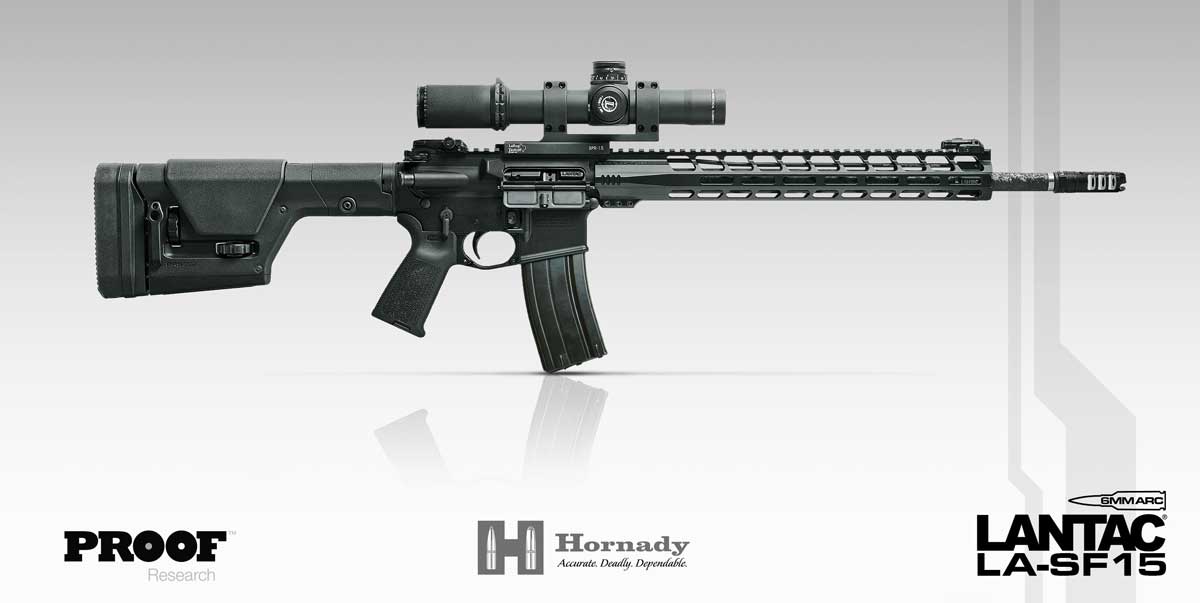
Lantac is one of the early adopters of the 6mm ARC, and this looks like one impressive rifle!
Hornady’s new 6mm Advanced Rifle Cartridge (ARC) is a 6mm cartridge based on a 6.5 Grendel case. This was a natural evolution, and it is not surprising that Hornady was the one to standardize such a cartridge since they have provided outstanding support for the Grendel from the start. This also makes the 6mm ARC vs. 6.5 Grendel conversation that much more interesting.
Most of the talk I have seen 6mm ARC compares it to the .308. I’ll just say here that in an AR, I’d rather have a 6.5 Grendel or 6mm ARC than a .308.
6mm ARC vs. 6.5 Grendel
The real comparison here is between the 6.5 Grendel and the 6mm ARC.
Both cartridges are compact cartridges. Their case design and capacity are very similar, and both are designed to be fired from an AR-15 (versus a larger framed rifle like an AR-10). This means that neither is going to deliver their best results with heaviest-for-caliber loads, and neither will gain the velocity of longer bolt-action cartridges, such as .234 Winchester or 6.5 Creedmoor.
However, velocity isn’t everything, and pushing a bullet too fast can be detrimental to accuracy. I suspect that Hornady understands this as their 6mm Creedmoor cartridges are only moderately faster than the 6mm ARC.
To keep our 6mm ARC vs. 6.5 Grendel comparison fair, we will compare published ballistics from Hornady. Hornady’s numbers come from 24” test barrels, so velocities may be slightly higher than from some shorter factory barrels. However, I find that Alexander Arms 6.5 Grendel barrels produce consistently higher velocities than other barrels. Hornady ammunition fired from my 18” Alexander Arms barrel averages only 40 fps slower than from Hornady’s 24” test barrel. (It also averages faster speeds than from some 20” and 22” barrels from other manufacturers.)
Also, I don’t know how fast the 6mm ARC builds velocity, so the velocities could be closer between the two cartridges in shorter barrels.
6.5 Grendel vs. 6mm ARC Ballistics
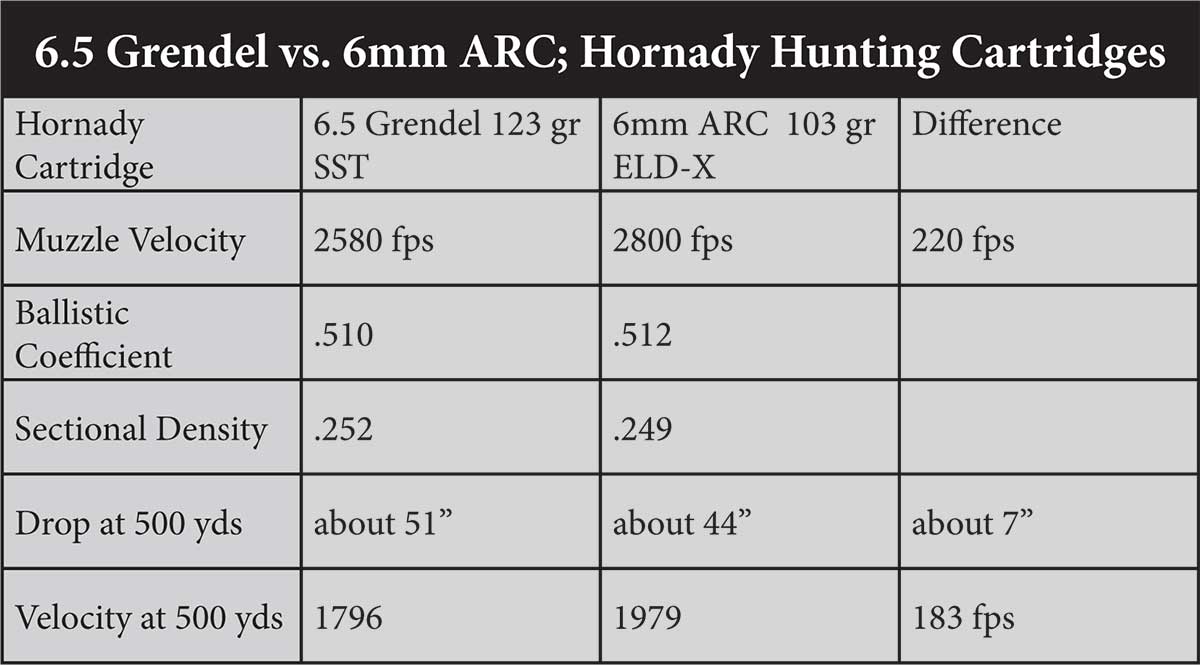
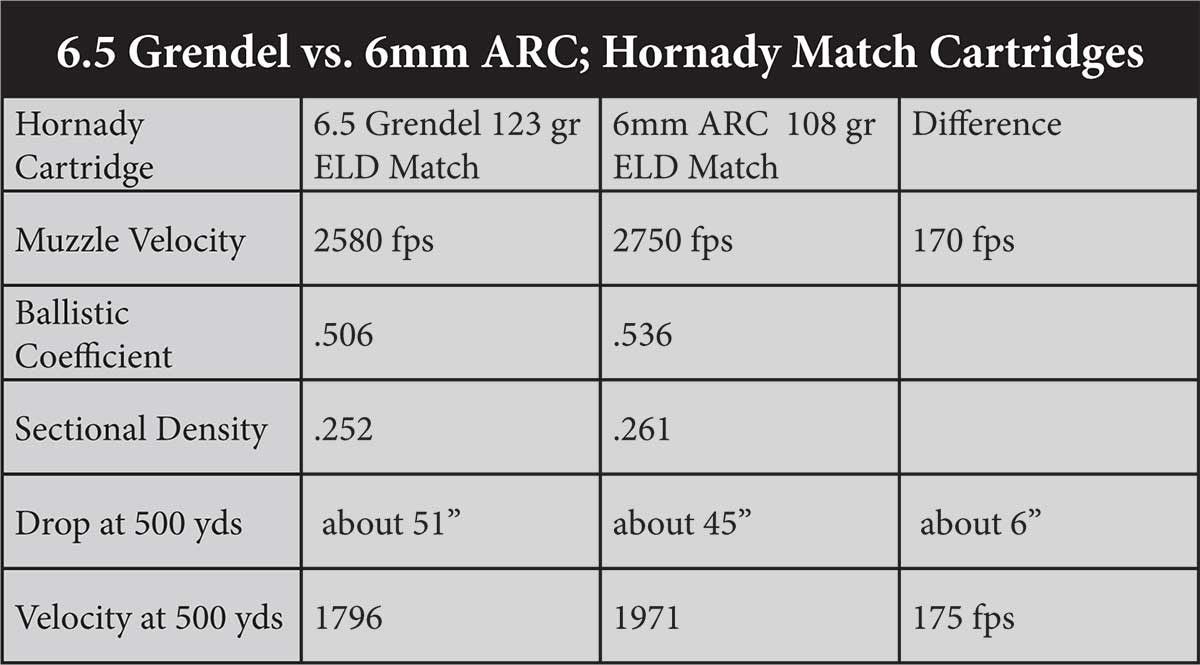
As you can see, velocities differ by 170 – 220 fps, with the lighter 6mm ARC moving faster from the compact case. This is exactly what we would expect.
Sectional densities are similar, and both should be good penetrators.
Ballistic coefficients are about equal, with a slight edge going to the 6mm 108 ELD Match. However, even with similar BCs, velocities come into play, and the increased velocity of the 6mm ARC translates to a slightly flatter trajectory.
Downrange velocities show how close the BCs and SDs are between the cartridges. The 175 – 183 fps difference in velocity at 500 yards shows the match cartridges are pretty comparable, with the 6.5 Grendel holding its velocity slightly better with the hunting loads.
Trajectories within reasonable hunting ranges are close. At 500 yards, the difference in drop is about 6 to 7 inches. To me, that difference is negligible.
When it comes to terminal ballistics, the Grendel has proven itself to me, with a lethal effect far in excess of what most people would expect from the wicked little cartridge. It is absolutely devastating on game and penetration is outstanding. I once fired a single 123 gr. Hornady SST completely through two goats, and the intervening space between, penetrating flesh and bone on both goats resulting in impressive exit wounds on both.
Both cartridges are sized for AR-15 rifles or mini-action bolt guns. Both will offer similar ballistics and terminal performance. They increase the lethality and penetration capabilities of the AR-15 well beyond the capabilities of the 5.56mm cartridge. Both vastly increase the versatility of the AR platform, covering varmint hunting, big game hunting, self-defense, and military roles with ease.
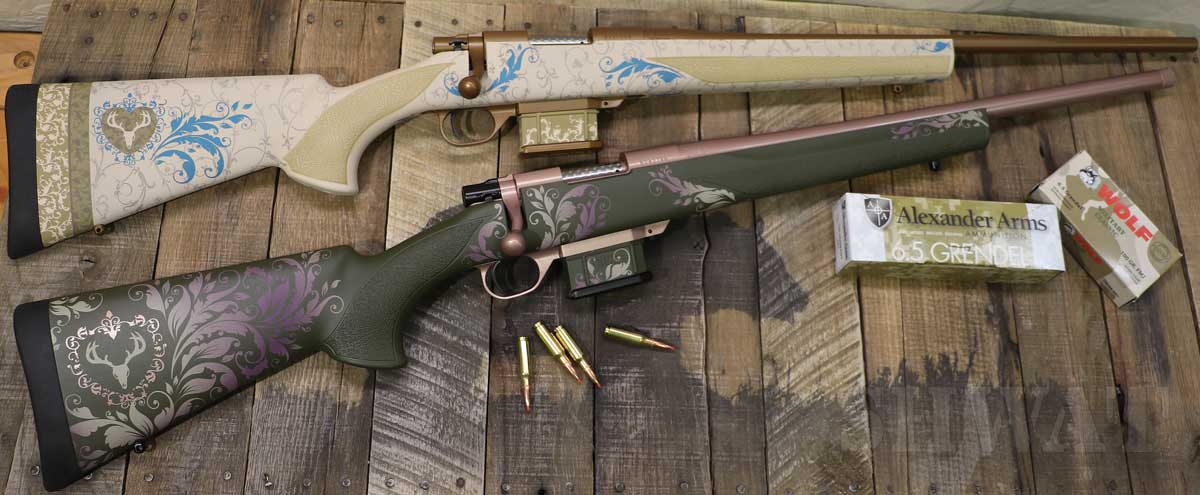
6mm ARC vs. 6.5 Grendel for Hunting
For hunting varmints, the 6mm ARC would have the advantage. Its lighter bullets are at home here. Given the ideal long-range bullet dimensions, the best long-range 6mm bullet will be around the 112 gr. weight. On the other hand, the best 6.5mm bullets will be closer to 140 gr. So, the 6mm will be a better choice for launching 95 gr. or 100 gr. varmint bullets, though the 6.5 Grendel is certainly capable.
For hunting deer-sized game, both the 6mm ARC and 6.5 Grendel will work fine. A lot of North American deer have fallen to 6mm and 6.5mm projectiles in the century or more since Winchester, Marlin, and others began offering 6mm chamberings.

Stepping up to moose, elk, caribou, and black bear – and maybe a wild pig or two – I’d certainly prefer the extra bullet weight of the 6.5 Grendel. Alexander Arms offers a load using the 120 gr. Barnes TSX bullet. It leaves my 18” barrel at 2,526 FPS. This is my go-to cartridge for hunting heavier game with the 6.5 Grendel. I would not hesitate to shoot a moose or black bear with this cartridge and carry it in my gun when hunting lighter game in brown bear country.
And while we’re talking about the Barnes TSX and TTSX bullets… I’m a huge fan. They expand reliably and consistently, yet even with expansion, they usually retain all or almost all their weight and penetrate deeply. They usually exit, even with quartering shots, causing faster bleeding, and easier tracking. I have no qualms about shooting a moose with a Barnes TSX from a 5.56. That will irritate some, but know that I grew up a subsistence hunter here in Alaska and didn’t come to that conclusion as a keyboard commando.
Would I shoot a moose with the 6mm ARC cartridge? Without hesitation. But my first choice for this purpose would be the Alexander Arms load in the 6.5 Grendel. At the ranges at which these bullets will expand reliably, the difference in velocity won’t make a difference, and the extra weight is an advantage.
Which one would I choose, the 6mm ARC or the 6.5 Grendel?
In an AR-15 or a small bolt action, both the 6.5 Grendel and the new 6mm ARC make outstanding big game cartridges for a child, with low recoil even when chambered in the lightest of rifles. A rifle like the CMMG RESOLUTE 6mm ARC rifle, which combines a rifle length gas system with a 16” barrel will soften recoil even further making it an ideal hunting rifle for smaller shooters.
For my own use, I’ll take the 6.5 Grendel over the 6mm ARC, but not by a wide margin. With velocities and trajectories very close, they are both practical for the same purposes. If I were strictly a long-range competition shooter, then I might go with the 6mm ARC as it has some small advantages. But a skilled shooter would do fine with either.
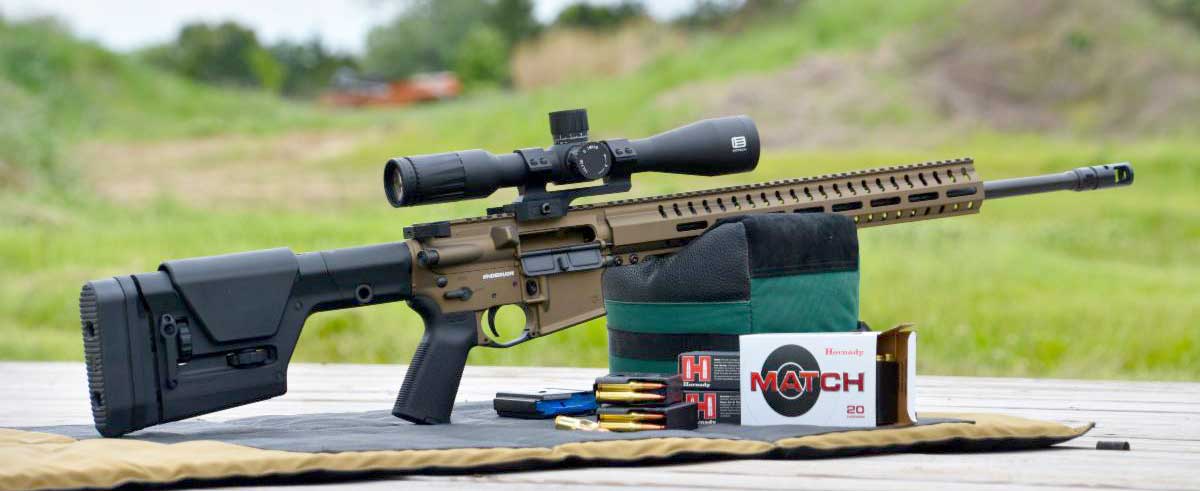
Another enticing 6mm ARC option, this one from CMMG
With Hornady behind the 6mm ARC cartridge, it is sure to be popular. I expect we will see companies like Barnes and Norma stepping in with TSX or TTSX loads, or perhaps something of their own design.
So while both are outstanding cartridges, I will stick with the 6.5 Grendel as my all-around, multi-purpose AR cartridge. That said, I would not feel under-gunned at all with the 6mm ARC. I’m also not promising that I won’t ever add one to the collection. CMMG’s 20” ENDEAVOR rifle has me thinking . . .


Fantastic article! And I will agree, it does seem like from similar BC bullets and barrel lengths, they are very close performance wise. I do wonder after this new caliber is used extensively in the “wild” (what I mean is, when it’s in the hands of thousands upon thousands of people), if there will be any skeletons in the closet that have to be remedied. I ask this because the .224 Valkyrie was also the “round to end all rounds” and it had growing pains that are just now being remedied. One gun article writer (after having shot the Barret Rec7 model that was used for the DOD contract) already expressed concern about the current selection of magazine offerings for the Grendel and how the shoulder change on the ARC might affect feeding. That being said, obviously Hornady didn’t think it was an issue since they submitted the design to the DOD. For my personal uses, the Grendel does everything I need it to do…and it has steel cased ammo available. However, if this cartridge is adopted by the military and parts and ammo become as available/cost effective as 5.56, I may make the switch.
Huge Grendel fan here, have four of them and it’s all I use now. I primarily hunt also so have come to the same conclusion as you. It offers another 150 yards of field performance at the expense of some bullet weight and diameter. A perfect class 2 game cartridge but you and I both will step up to class 3 with Grendel and I hunt sheep in Grizz country as well. I shot a moose with a Grendel in 2018, it did incredible.
I meant to say the 6 arc offers another 150 yards of field performance, at the expense of billet weight and diam. Since most hunting sub 600 yards by a long shot, the Grendel wins. Strictly class 2 game and lots of long range plinking there 6 arc would be great. I only run bolt actions and factory hornady black, it’s been awesome.
If you are using a bolt action why are you messing with either of these cartridges? There are better choices when not constrained by AR magazine length and pressure limitations (published data for either is limited to about 52k PSI.)
Because the bolt action rifles designed around the 6.5 Grendel are built on “mini action” receivers which means the rifles can be significantly smaller and lighter. A significantly smaller and lighter bolt action rifle with the capability of shooting the highest BC variants of the 6.5 Grendel is a great all around hunting or target package.
Stopped reading when the author made up some cartridge by the name of “Creedmore”, it’s too bad, this could’ve been a good article but it’s hard to take someone seriously when they can’t spell cartridge names.
Ever worked hard until 3 a.m. only to have spell check and your search engine plugin screw you like that? No? Well, gosh, you caught us. Clearly the author and editor have no idea how to spell. Must be some noobs to guns, right? Maybe you could do better? But still, thanks for pointing that out. We’ve corrected it, and even given you the credit here… 😉
Don’t be a negative Nancy. We have enough of that in the world.
I find your articles to be logical and informative. When I first read about the 6mm ARC, I decided it was a cartridge for which there is no practical need, since we already have access to inexpensive plinking and excellent hunting ammunition available for the 6.5 Grendel. I’m keeping my 6.5 Grendel upper, and will likely be buying another with a slightly longer barrel so I can get the same performance from the 6.5 as the new 6mm claims it can do. Thanks for another level headed and we’ll written piece.
Don’t own any Grendel’s but a lot of Creedmoors so I liked the article. Waiting for my 6mm ARC barrels to come in. We have developed a powder coated cast bullet in 6mm 100gr that fits 6×45 and 6mm Creedmoor. 6mm ARC is perfectly in the middle of design requirements so looking forward to testing it out.
Guys If your going to compare you need t do this right WTF!. If you take 20 in Barrels using the Same Gr bullet 108gr and then shoot you can make the claims other wise it just sale and BS and I’ll cal Bull shit ever time with your data. Example 6.5 Grendel 108 molly come out of a Grendel at over 2700+ ft/s with 20 in barrel so let do the same with the 6 mm Arc and yes about the same but .5 mm larger so nee to compare apples to apples. Okay let shoot a 120 gr 6 mm arc or 123 gr and see the ballistic. betting the 6.5 Grendel meets or exceeds the Arc at that weight. But no you compare a 103 or 108 to a 123 gr bullet. Ever here of newtons laws of gravity. wow Apple to Oranges here WTF!
The problem with ballistics is that it is a difficult subject to understand. It may seem that you can simply compare two bullets of the same weight in different diameters, but that is not the case.
To be fair in how we compare cartridges of different calibers, we have to compare similar bullets for each caliber. That means we have to compare bullets of similar ballistic coefficient, sectional density, design, and construction. To make this easier to understand, let’s imagine we were comparing .308 to .30-06, which shoots the same diameter bullet. If I compared the performance of a 220 grain round nose .30-06 load to a 168 gr. match .308 load, you would say it was an unfair comparison, and it would be.
Now with the 6.5 Grendel and 6mm ARC, to make a fair comparison, we have to compare not just the cartridges, but loads that use comparable bullets, as far as design, BC, SD, etc.
That means that 108-112 gr 6mm bullets are to that caliber what 130-140 gr bullets are to 6.5mm, roughly.
So, while a 108 gr 6mm bullet is reaching peak performance for the ARC, a 108 gr bullet in a 6.5 Grendel may get a lot of speed initially, but will soon bleed velocity and begin to drop more rapidly than a heavier bullet would. On the other hand, I don’t know if the 6mm ARC chamber could allow for a 120 gr bullet, and if it did, I bet it would have to be a round-nosed monster with the flight characteristics of a garbage truck. The Grendel would stomp all over it at that weight.
So to make a fair comparison between cartridges with dissimilar diameters, we compare certain things, like velocities, trajectories, wind resistance, penetration potential, downrange velocities, terminal performance, etc. But to do that, we have to compare the loads that each cartridge was designed to shoot, because to compare anything else doesn’t help anyone make an educated decision.
Since the 6mm ARC is designed to shoot bullets around 110 grain, and the 6.5 Grendel is designed to perform best with bullets in the 120-130 gr range, this is where we have to compare the performance of the two. Because of this, I recognize the great characteristics of the 6mm ARC, but I decided to stick with the Grendel, because it is giving me the performance I want for my purposes, and the ARC isn’t giving me any real advantages over the Grendel. The Grendel, because it can perform with the heavier bullets, as well as lighter ones if needed, gives me a lot more versatility. With the Grendel, I can hunt anything from varmints to moose.
Thank you for comparing the cartridges with designed for / typical usage bullets! It provides more useful value to my selection decision.
I very much agree with John and his valid point. Why is the Grendel always compared to other cartridges and using a heavier bullet? I also would like to see testing done with equal weights. It is not like there are not 100 gr and 108 gr bullets for the Grendel, 100 gr A-Max, Lapua 108 gr Scenar ect.
I also grew up subsistence in Alaska and would not tackle moose with a 223. I have seen them absorb multiple quality jits from a 30-30 or even a 444 marlin. Something that can break ribs is preferable.
My son attempted to harvest a mule deer with a 62 grain tsx last year. Blood all down the shoulder, bone fragments at impact site. Never found the deer. This year, more gun.
That being said, have you tested the new barnes 115 ttsx in the Grebdel yet? I can’t find any. My other son took a large mule deer at 275 yds with a Grendel (Howa mini bolt) last year. Hornafy sst
Love those Howa mini-actions!
A lot of how bullets perform has to do with shot placement. Bone fragments tell me that the bullet exited, which is what the TSX is designed to do. Average expansion is to .45” consistently, and they consistently retain their weight. So a .45” expanded projectile that exited SHOULD kill well if shot placement was correct.
However, even if the shot placement is correct, and the animal is dead, how that particular animal reacts when hit can vary greatly. One animal may drop, another may run a long way with an identical shot.
We don’t always recover every animal due to these variables, as much as we would like to pretend we do.
I’m confident in the ability of the 5.56 with the right bullet to kill a moose. But I’m not as confident with its SUITABILITY. with 5.56 I’m limited in the shots I’m confident to take. I’m limited in ranges at which bullets will perform.
I think it is important in making decisions about what gun to use, we have to differentiate between what might work, what usually works, and what works well.
A 9mm pistol might stop a bear. They have before. A .44 mag usually works to stop a Bear when everything is right. But a .45-70 works well.
That’s why I’m with you on the 6.5 Grendel. It gives me the edge for hunting that the 5.56 does not.
I’ve had great results with Hornady SST in the Grendel as well. Killed 2 goats with one shot, through and through on both animals including bone.
So what’s the future of your modern weapon mix? AR-15 SBR in 300BLK subsonic and supersonic for <300yds, 6mmARC for 300yds – 1000yds and then maybe AR-10 in 6.5mm Creedmore if you want that second weapon?
Great article and good comparison. I’ve been thinking of building a grendel upper for a while now this may have motivated me to do so. However, I was hoping to see energy compared as well.
At 500 yards the heavier 6.5 Grendal will be more forgiving to windage adjustments.